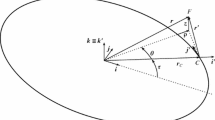Abstract
The analytic Keplerian 6 × 6 Earth Centered Inertial state transition matrix developed by Goodyear, Battin, and other mathematicians is well known. The primary objectives of this paper are to present a relatively simple formulation of the Keplerian state transition matrix, and to show that the higher-order secular terms associated with the state transition matrices of Goodyear and Battin can be eliminated. Analytic and numerical results indicate that the concern about these unbounded secular terms for numerical integration is not warranted. Comparison of Keplerian, Vinti, and numerical state transition matrices in the Hill-Clohessy-Wiltshire coordinate system (local-vertical coordinate system) further supports this contention since the two secular elements of the Keplerian state transition matrix match closely with those of the Vinti and numerical state transition matrices.
Similar content being viewed by others
References
BATTIN, R. H. An Introduction to The Mathematics and Methods of Astrodynamics, American Institute of Aeronautics and Astronautics, Education Series, New York, 1987.
DANBY, J. M. A., and BURKARDT, T. M. “The Solution of Kepler’s Equation, I,” Celestial Mechanics, Vol. 31, 1983, pp. 95–107.
BURKARDT, T. M., and DANBY, J. M. A. “The Solution of Kepler’s Equation, II,” Celestial Mechanics, Vol. 31, 1983, pp. 317–328.
ODELL, A. W., and GOODING, R. H. “Procedures for Solving Kepler’s Equation,” Celestial Mechanics, Vol. 38, 1986, pp. 307–334.
CONWAY, B. A. “An Improved Method due to Lagurerre for the Solution of Kepler’s Equation,” Celestial Mechanics, Vol. 39, 1986, pp. 199–211.
DANBY, J. M. A. “The Solution of Kepler’s Equation, III,” Celestial Mechanics, Vol. 40, 1987, pp. 303–312.
STUMPFF, P. “The General Kepler Equation and its Solutions,” Celestial Mechanics, Vol. 43, 1988, pp. 211–222.
TAFF, L. G., and BRENNAN, T. A. “On Solving Kepler’s Equation,” Celestial Mechanics and Dynamical Astronomy, Vol. 46, 1989, pp. 163–176.
MIKKOLA, S. “A Cubic Approximation for Kepler’s Equation,” Celestial Mechanics, Vol. 40, 1987, pp. 329–334.
MARKLEY, F. L. “Kepler Equation Solver,” Flight Mechanics/Estimation Theory Symposium, 47–57, NASA Goddard Space Flight Center, Greenbelt, Maryland, 1995.
NIJENHUIS, A. “Solving Kepler Equation with High Efficiency and Accuracy,” Celestial Mechanics and Dynamical Astronomy, 1991, pp. 319–330.
FITZ-COY, N., and JANG, J. “Homotopy Solution of Kepler’s Equation,” Flight Mechanics/ Estimation Theory Symposium, NASA Goddard Space Flight Center, Greenbelt, Maryland, 1996, pp. 307–314.
COLWELL, P. Solving Kepler’s Equation Over Three Centuries, Willman-Bell, Richmond, Virginia, 1993.
PRUSSING, J. E., and CONWAY, B. A. Orbital Mechanics, Oxford University, New York, 1993.
CHOBOTOV, V. A. (ed.), CHAO, C. C., KARRENBERG, H. K., LANG, T. L., and MIYAMOTO, J. Y. Orbital Mechanics, American Institute of Aeronautics, Education Series, New York, 1991.
GOODYEAR, W. H. “Complete General Closed-Form Solution for Coordinates and Partial Derivatives of the Two-Body Problem,” The Astronomical Journal, Vol. 70, No. 3, 1965, pp. 189–192.
GOODYEAR, W. H. “A General Method for the Cartesian Coordinates and Partial Derivatives of the Two-Body Problem,” IBM Federal Systems Division, NASA CR-522, Langley, Virginia, 1966.
STUMPFF, K. “Neue Formeln und Hilfstafeln zur Ephemeridenrechung,” Astr. Nach., Vol. 275, 1947, pp. 108–128.
SPERLING, H. “Computation of Keplerian Conic Sections,” American Rocket Society Journal, Vol. 31, 1961, pp. 660–661.
DANBY, J. M. A. Fundamentals of Celestial Mechanics, MacMillan, New York, 1962.
HERRICK, S.H. “Universal Variables,” The Astronautical Journal, Vol. 70, 1965, pp. 309–315.
LEMMON, W. W., and BROOKS, J. E. “A Universal Formulation for Conic Trajectories-Basic Variables and Relationships,” Rept. 3400-6019-TU000, TRW/Systems, Redondo Beach, California, 1965.
PITKIN, E. T. “Second Transitional Partial Derivatives Via Universal Variables,” Journal of the Astronautical Sciences, Vol. 13, No. 5, 1966, pp. 204–207.
SHEPPERD, S. W. “Universal Keplerian State Transition Matrix,” Celestial Mechanics, Vol. 35, 1985, pp. 129–144.
KOCHI, K. C. “Error Parameters and Error Propagation Models for On-Orbit Navigation and Guidance Analyses,” Rockwell Internal Letter No. D/383-350-79-003, Rockwell International, Downey, California, January 1979.
DER, G. J. “An Universal Error Propagation Model for On-Orbit Navigation and Guidance Analyses,” Rockwell Internal Letter No. D/385-122-84-125 AD38, Rockwell International, Downey, California, September 1984.
BATTIN, R. H., CROOPNICK, S. R., and LENOX, J. E. “The Epoch State Navigation Filter,” Journal of Guidance and Control, Vol. 1, No. 5, 1978, pp. 359–364.
BORN, G. H., CHRISTENSEN, E. J., and SEVERSIKE, L. K. “Special Perturbations Employing Osculating Reference States,” Celestial Mechanics, Vol. 9, 1974, pp. 41–53.
DER, G. J. “Runge-Kutta Integration Methods for Trajectory Propagation Revisited,” AAS Paper 95–420, AAS/AIAA Astrodynamics Conference, Halifax, Canada, August 1995.
DER, G. J., and DANCHICK, R. “Analytic and Numerical Error Covariance Propagation,” AAS Paper 96–3661, AAS/AIAA Astrodynamics Conference, San Diego, California, July 1996.
Author information
Authors and Affiliations
Rights and permissions
About this article
Cite this article
Der, G.J. An Elegant State Transition Matrix. J of Astronaut Sci 45, 371–390 (1997). https://doi.org/10.1007/BF03546398
Published:
Issue Date:
DOI: https://doi.org/10.1007/BF03546398




